The Saddam Hussein Trial: Examining War Crimes and Global Justice
VerifiedAdded on 2023/06/11
|9
|2445
|67
Case Study
AI Summary
This case study delves into the trial of Saddam Hussein, the former President of Iraq, focusing on the war crimes and crimes against humanity for which he was prosecuted. It details his oppressive regime, particularly the atrocities committed against the Kurdish population, including the al-Anfal campaign and the Halabja gassing. The report outlines the key events leading to his capture by US forces, the charges against him, and the timeline of his trial, including significant moments like his initial court appearance and eventual sentencing. The study also enumerates a list of Saddam Hussein's alleged crimes, such as the Dawa Killings, Fayli Deportations, Barzani Abductions, and the invasion of Kuwait. Ultimately, the case study concludes with Saddam Hussein's execution and the resulting instability in Iraq, highlighting his complex legacy as both a villain and a perceived hero by different segments of the population. Desklib provides students with access to similar case studies and solved assignments.
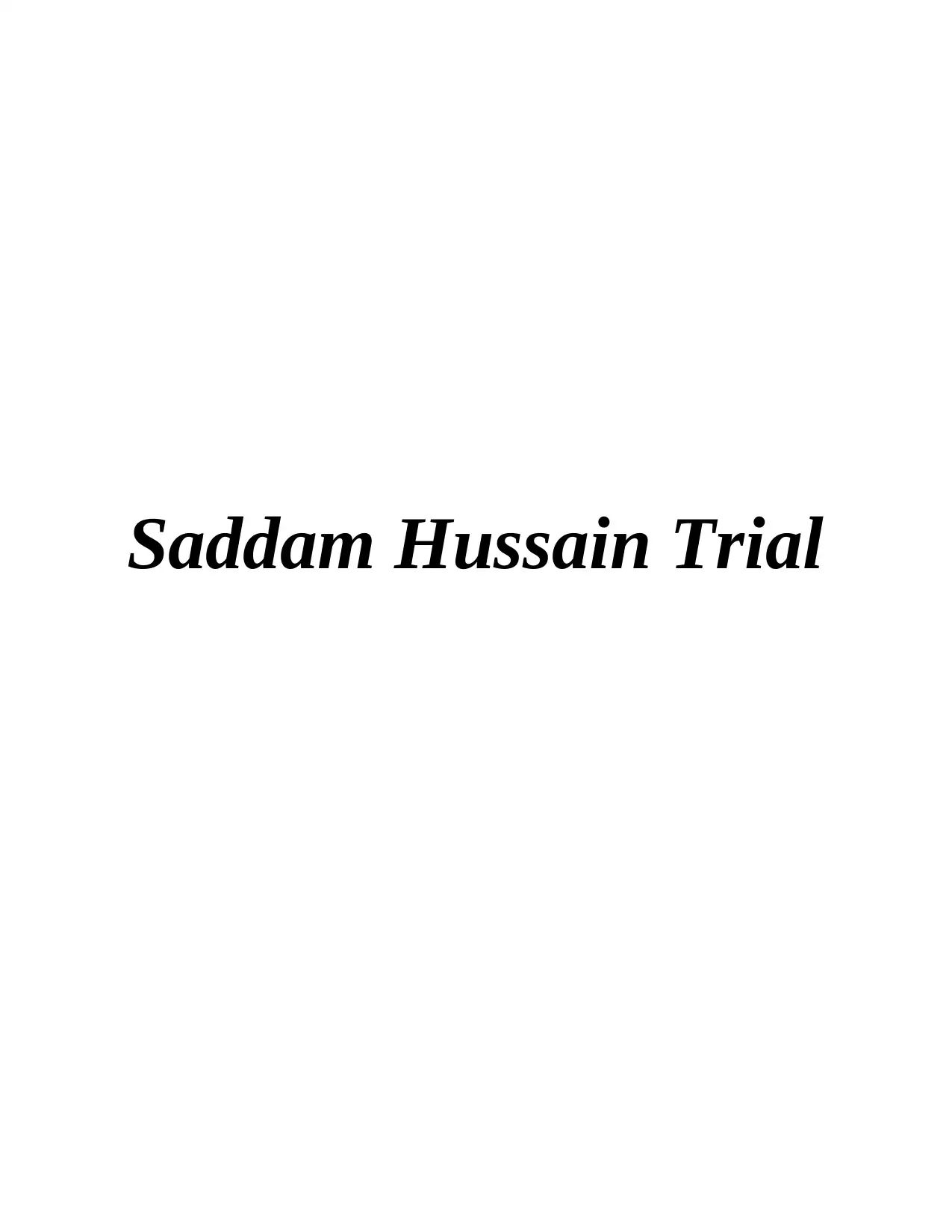
Saddam Hussain Trial
Paraphrase This Document
Need a fresh take? Get an instant paraphrase of this document with our AI Paraphraser
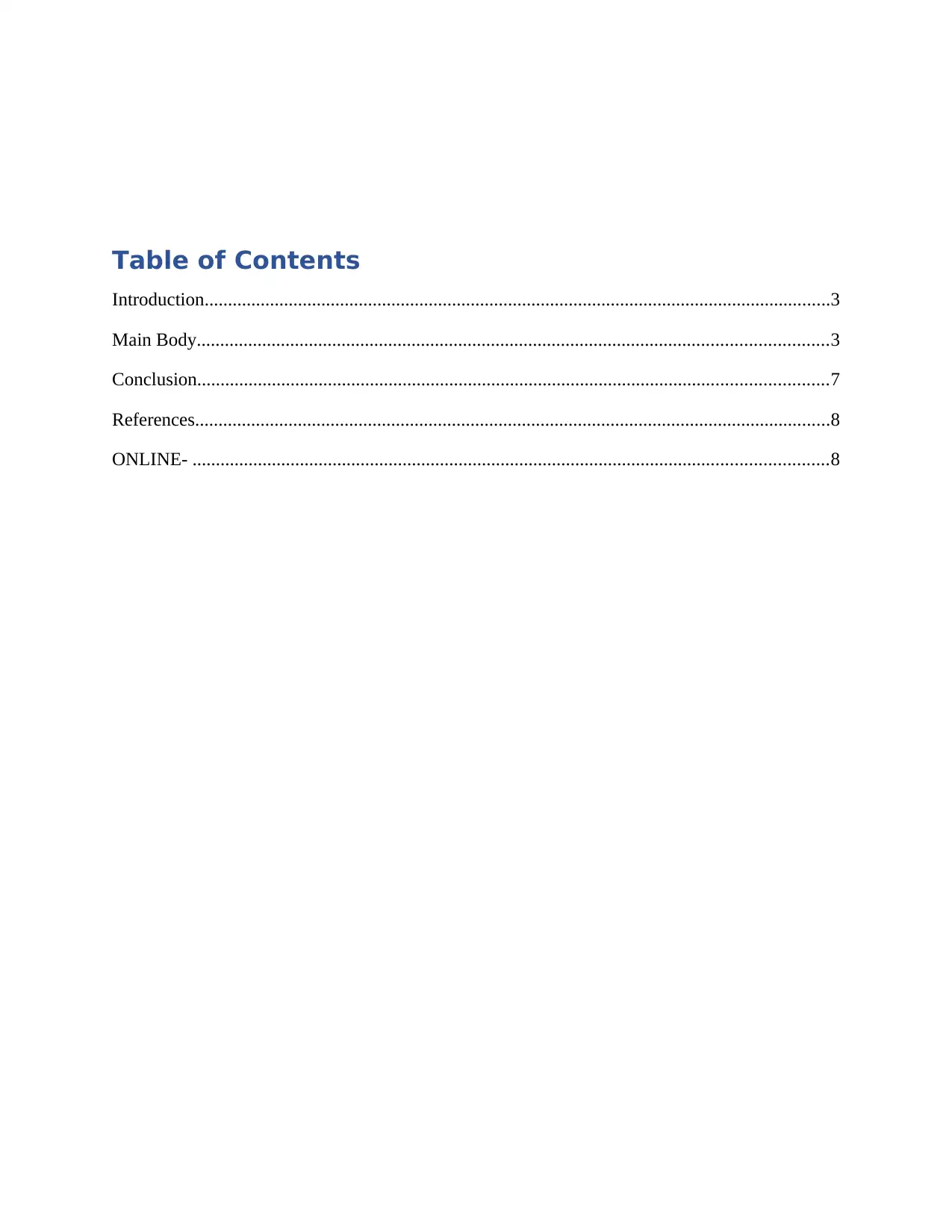
Table of Contents
Introduction......................................................................................................................................3
Main Body.......................................................................................................................................3
Conclusion.......................................................................................................................................7
References........................................................................................................................................8
ONLINE- ........................................................................................................................................8
Introduction......................................................................................................................................3
Main Body.......................................................................................................................................3
Conclusion.......................................................................................................................................7
References........................................................................................................................................8
ONLINE- ........................................................................................................................................8
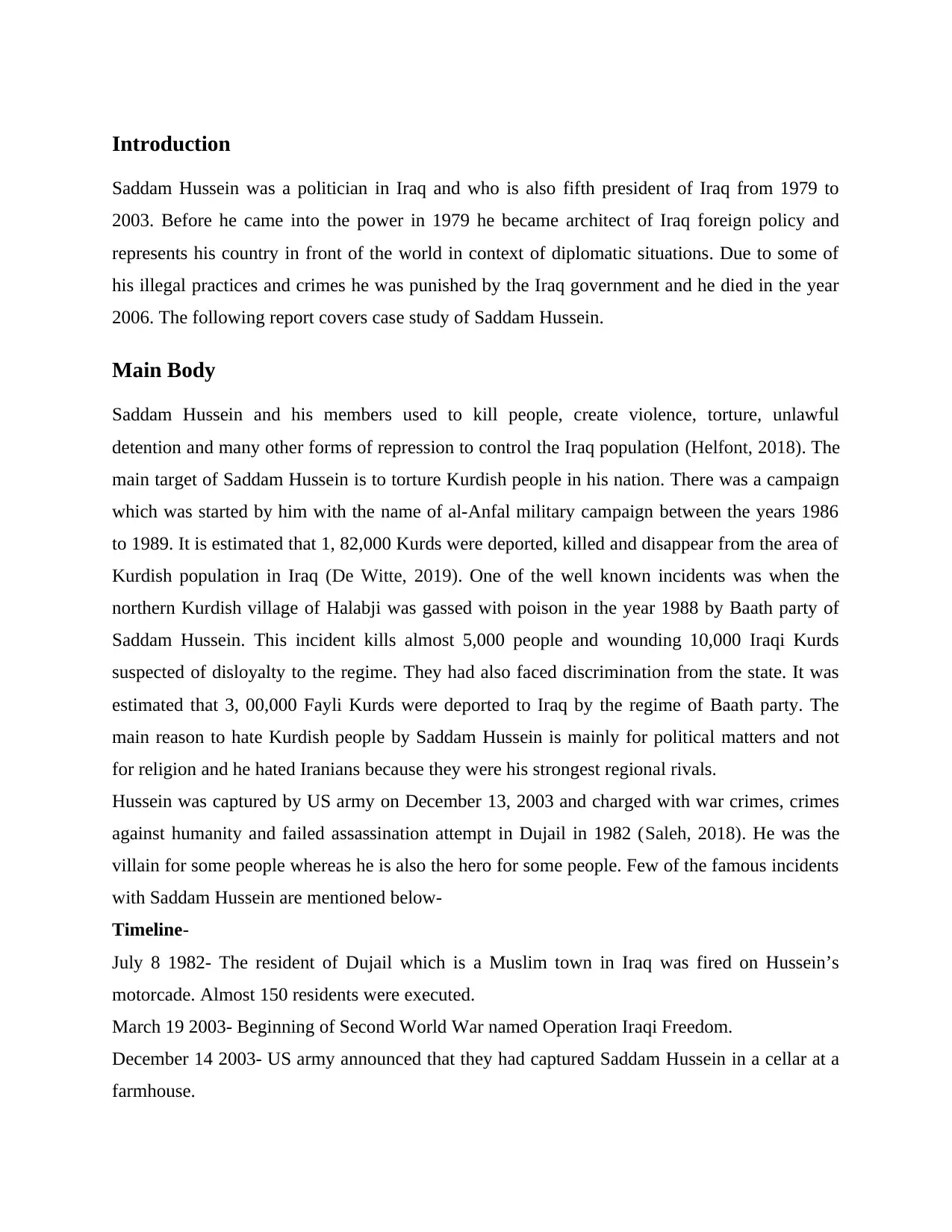
Introduction
Saddam Hussein was a politician in Iraq and who is also fifth president of Iraq from 1979 to
2003. Before he came into the power in 1979 he became architect of Iraq foreign policy and
represents his country in front of the world in context of diplomatic situations. Due to some of
his illegal practices and crimes he was punished by the Iraq government and he died in the year
2006. The following report covers case study of Saddam Hussein.
Main Body
Saddam Hussein and his members used to kill people, create violence, torture, unlawful
detention and many other forms of repression to control the Iraq population (Helfont, 2018). The
main target of Saddam Hussein is to torture Kurdish people in his nation. There was a campaign
which was started by him with the name of al-Anfal military campaign between the years 1986
to 1989. It is estimated that 1, 82,000 Kurds were deported, killed and disappear from the area of
Kurdish population in Iraq (De Witte, 2019). One of the well known incidents was when the
northern Kurdish village of Halabji was gassed with poison in the year 1988 by Baath party of
Saddam Hussein. This incident kills almost 5,000 people and wounding 10,000 Iraqi Kurds
suspected of disloyalty to the regime. They had also faced discrimination from the state. It was
estimated that 3, 00,000 Fayli Kurds were deported to Iraq by the regime of Baath party. The
main reason to hate Kurdish people by Saddam Hussein is mainly for political matters and not
for religion and he hated Iranians because they were his strongest regional rivals.
Hussein was captured by US army on December 13, 2003 and charged with war crimes, crimes
against humanity and failed assassination attempt in Dujail in 1982 (Saleh, 2018). He was the
villain for some people whereas he is also the hero for some people. Few of the famous incidents
with Saddam Hussein are mentioned below-
Timeline-
July 8 1982- The resident of Dujail which is a Muslim town in Iraq was fired on Hussein’s
motorcade. Almost 150 residents were executed.
March 19 2003- Beginning of Second World War named Operation Iraqi Freedom.
December 14 2003- US army announced that they had captured Saddam Hussein in a cellar at a
farmhouse.
Saddam Hussein was a politician in Iraq and who is also fifth president of Iraq from 1979 to
2003. Before he came into the power in 1979 he became architect of Iraq foreign policy and
represents his country in front of the world in context of diplomatic situations. Due to some of
his illegal practices and crimes he was punished by the Iraq government and he died in the year
2006. The following report covers case study of Saddam Hussein.
Main Body
Saddam Hussein and his members used to kill people, create violence, torture, unlawful
detention and many other forms of repression to control the Iraq population (Helfont, 2018). The
main target of Saddam Hussein is to torture Kurdish people in his nation. There was a campaign
which was started by him with the name of al-Anfal military campaign between the years 1986
to 1989. It is estimated that 1, 82,000 Kurds were deported, killed and disappear from the area of
Kurdish population in Iraq (De Witte, 2019). One of the well known incidents was when the
northern Kurdish village of Halabji was gassed with poison in the year 1988 by Baath party of
Saddam Hussein. This incident kills almost 5,000 people and wounding 10,000 Iraqi Kurds
suspected of disloyalty to the regime. They had also faced discrimination from the state. It was
estimated that 3, 00,000 Fayli Kurds were deported to Iraq by the regime of Baath party. The
main reason to hate Kurdish people by Saddam Hussein is mainly for political matters and not
for religion and he hated Iranians because they were his strongest regional rivals.
Hussein was captured by US army on December 13, 2003 and charged with war crimes, crimes
against humanity and failed assassination attempt in Dujail in 1982 (Saleh, 2018). He was the
villain for some people whereas he is also the hero for some people. Few of the famous incidents
with Saddam Hussein are mentioned below-
Timeline-
July 8 1982- The resident of Dujail which is a Muslim town in Iraq was fired on Hussein’s
motorcade. Almost 150 residents were executed.
March 19 2003- Beginning of Second World War named Operation Iraqi Freedom.
December 14 2003- US army announced that they had captured Saddam Hussein in a cellar at a
farmhouse.
⊘ This is a preview!⊘
Do you want full access?
Subscribe today to unlock all pages.

Trusted by 1+ million students worldwide
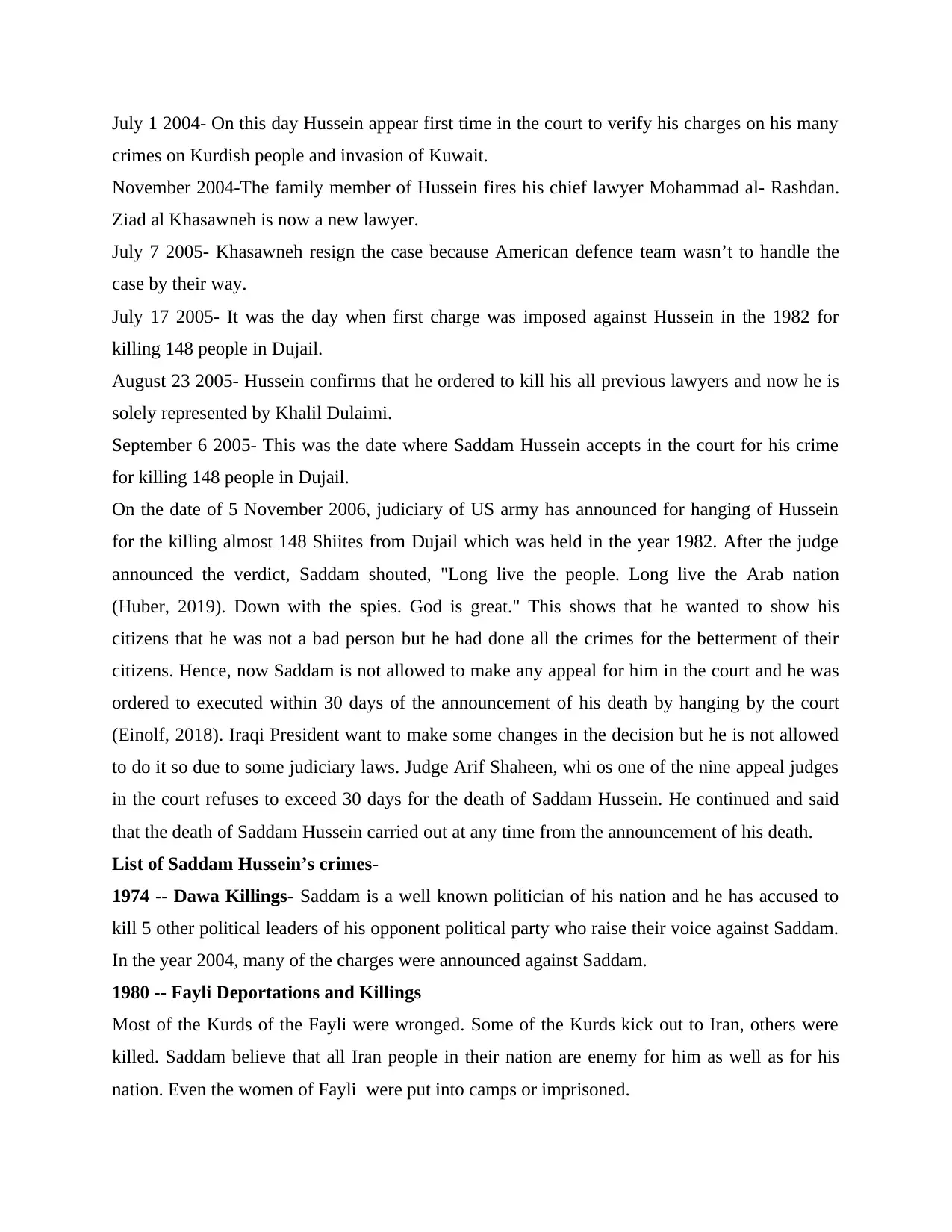
July 1 2004- On this day Hussein appear first time in the court to verify his charges on his many
crimes on Kurdish people and invasion of Kuwait.
November 2004-The family member of Hussein fires his chief lawyer Mohammad al- Rashdan.
Ziad al Khasawneh is now a new lawyer.
July 7 2005- Khasawneh resign the case because American defence team wasn’t to handle the
case by their way.
July 17 2005- It was the day when first charge was imposed against Hussein in the 1982 for
killing 148 people in Dujail.
August 23 2005- Hussein confirms that he ordered to kill his all previous lawyers and now he is
solely represented by Khalil Dulaimi.
September 6 2005- This was the date where Saddam Hussein accepts in the court for his crime
for killing 148 people in Dujail.
On the date of 5 November 2006, judiciary of US army has announced for hanging of Hussein
for the killing almost 148 Shiites from Dujail which was held in the year 1982. After the judge
announced the verdict, Saddam shouted, "Long live the people. Long live the Arab nation
(Huber, 2019). Down with the spies. God is great." This shows that he wanted to show his
citizens that he was not a bad person but he had done all the crimes for the betterment of their
citizens. Hence, now Saddam is not allowed to make any appeal for him in the court and he was
ordered to executed within 30 days of the announcement of his death by hanging by the court
(Einolf, 2018). Iraqi President want to make some changes in the decision but he is not allowed
to do it so due to some judiciary laws. Judge Arif Shaheen, whi os one of the nine appeal judges
in the court refuses to exceed 30 days for the death of Saddam Hussein. He continued and said
that the death of Saddam Hussein carried out at any time from the announcement of his death.
List of Saddam Hussein’s crimes-
1974 -- Dawa Killings- Saddam is a well known politician of his nation and he has accused to
kill 5 other political leaders of his opponent political party who raise their voice against Saddam.
In the year 2004, many of the charges were announced against Saddam.
1980 -- Fayli Deportations and Killings
Most of the Kurds of the Fayli were wronged. Some of the Kurds kick out to Iran, others were
killed. Saddam believe that all Iran people in their nation are enemy for him as well as for his
nation. Even the women of Fayli were put into camps or imprisoned.
crimes on Kurdish people and invasion of Kuwait.
November 2004-The family member of Hussein fires his chief lawyer Mohammad al- Rashdan.
Ziad al Khasawneh is now a new lawyer.
July 7 2005- Khasawneh resign the case because American defence team wasn’t to handle the
case by their way.
July 17 2005- It was the day when first charge was imposed against Hussein in the 1982 for
killing 148 people in Dujail.
August 23 2005- Hussein confirms that he ordered to kill his all previous lawyers and now he is
solely represented by Khalil Dulaimi.
September 6 2005- This was the date where Saddam Hussein accepts in the court for his crime
for killing 148 people in Dujail.
On the date of 5 November 2006, judiciary of US army has announced for hanging of Hussein
for the killing almost 148 Shiites from Dujail which was held in the year 1982. After the judge
announced the verdict, Saddam shouted, "Long live the people. Long live the Arab nation
(Huber, 2019). Down with the spies. God is great." This shows that he wanted to show his
citizens that he was not a bad person but he had done all the crimes for the betterment of their
citizens. Hence, now Saddam is not allowed to make any appeal for him in the court and he was
ordered to executed within 30 days of the announcement of his death by hanging by the court
(Einolf, 2018). Iraqi President want to make some changes in the decision but he is not allowed
to do it so due to some judiciary laws. Judge Arif Shaheen, whi os one of the nine appeal judges
in the court refuses to exceed 30 days for the death of Saddam Hussein. He continued and said
that the death of Saddam Hussein carried out at any time from the announcement of his death.
List of Saddam Hussein’s crimes-
1974 -- Dawa Killings- Saddam is a well known politician of his nation and he has accused to
kill 5 other political leaders of his opponent political party who raise their voice against Saddam.
In the year 2004, many of the charges were announced against Saddam.
1980 -- Fayli Deportations and Killings
Most of the Kurds of the Fayli were wronged. Some of the Kurds kick out to Iran, others were
killed. Saddam believe that all Iran people in their nation are enemy for him as well as for his
nation. Even the women of Fayli were put into camps or imprisoned.
Paraphrase This Document
Need a fresh take? Get an instant paraphrase of this document with our AI Paraphraser
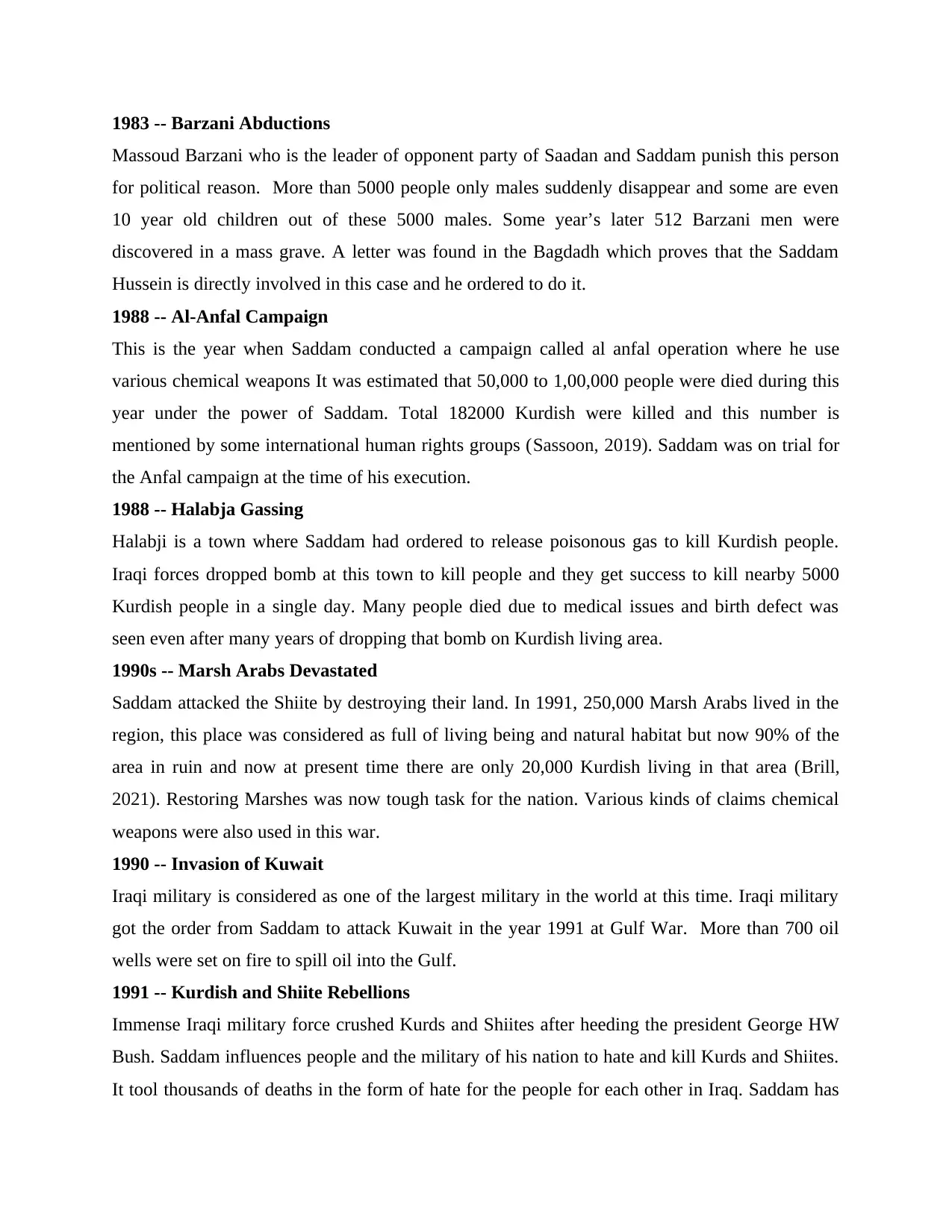
1983 -- Barzani Abductions
Massoud Barzani who is the leader of opponent party of Saadan and Saddam punish this person
for political reason. More than 5000 people only males suddenly disappear and some are even
10 year old children out of these 5000 males. Some year’s later 512 Barzani men were
discovered in a mass grave. A letter was found in the Bagdadh which proves that the Saddam
Hussein is directly involved in this case and he ordered to do it.
1988 -- Al-Anfal Campaign
This is the year when Saddam conducted a campaign called al anfal operation where he use
various chemical weapons It was estimated that 50,000 to 1,00,000 people were died during this
year under the power of Saddam. Total 182000 Kurdish were killed and this number is
mentioned by some international human rights groups (Sassoon, 2019). Saddam was on trial for
the Anfal campaign at the time of his execution.
1988 -- Halabja Gassing
Halabji is a town where Saddam had ordered to release poisonous gas to kill Kurdish people.
Iraqi forces dropped bomb at this town to kill people and they get success to kill nearby 5000
Kurdish people in a single day. Many people died due to medical issues and birth defect was
seen even after many years of dropping that bomb on Kurdish living area.
1990s -- Marsh Arabs Devastated
Saddam attacked the Shiite by destroying their land. In 1991, 250,000 Marsh Arabs lived in the
region, this place was considered as full of living being and natural habitat but now 90% of the
area in ruin and now at present time there are only 20,000 Kurdish living in that area (Brill,
2021). Restoring Marshes was now tough task for the nation. Various kinds of claims chemical
weapons were also used in this war.
1990 -- Invasion of Kuwait
Iraqi military is considered as one of the largest military in the world at this time. Iraqi military
got the order from Saddam to attack Kuwait in the year 1991 at Gulf War. More than 700 oil
wells were set on fire to spill oil into the Gulf.
1991 -- Kurdish and Shiite Rebellions
Immense Iraqi military force crushed Kurds and Shiites after heeding the president George HW
Bush. Saddam influences people and the military of his nation to hate and kill Kurds and Shiites.
It tool thousands of deaths in the form of hate for the people for each other in Iraq. Saddam has
Massoud Barzani who is the leader of opponent party of Saadan and Saddam punish this person
for political reason. More than 5000 people only males suddenly disappear and some are even
10 year old children out of these 5000 males. Some year’s later 512 Barzani men were
discovered in a mass grave. A letter was found in the Bagdadh which proves that the Saddam
Hussein is directly involved in this case and he ordered to do it.
1988 -- Al-Anfal Campaign
This is the year when Saddam conducted a campaign called al anfal operation where he use
various chemical weapons It was estimated that 50,000 to 1,00,000 people were died during this
year under the power of Saddam. Total 182000 Kurdish were killed and this number is
mentioned by some international human rights groups (Sassoon, 2019). Saddam was on trial for
the Anfal campaign at the time of his execution.
1988 -- Halabja Gassing
Halabji is a town where Saddam had ordered to release poisonous gas to kill Kurdish people.
Iraqi forces dropped bomb at this town to kill people and they get success to kill nearby 5000
Kurdish people in a single day. Many people died due to medical issues and birth defect was
seen even after many years of dropping that bomb on Kurdish living area.
1990s -- Marsh Arabs Devastated
Saddam attacked the Shiite by destroying their land. In 1991, 250,000 Marsh Arabs lived in the
region, this place was considered as full of living being and natural habitat but now 90% of the
area in ruin and now at present time there are only 20,000 Kurdish living in that area (Brill,
2021). Restoring Marshes was now tough task for the nation. Various kinds of claims chemical
weapons were also used in this war.
1990 -- Invasion of Kuwait
Iraqi military is considered as one of the largest military in the world at this time. Iraqi military
got the order from Saddam to attack Kuwait in the year 1991 at Gulf War. More than 700 oil
wells were set on fire to spill oil into the Gulf.
1991 -- Kurdish and Shiite Rebellions
Immense Iraqi military force crushed Kurds and Shiites after heeding the president George HW
Bush. Saddam influences people and the military of his nation to hate and kill Kurds and Shiites.
It tool thousands of deaths in the form of hate for the people for each other in Iraq. Saddam has
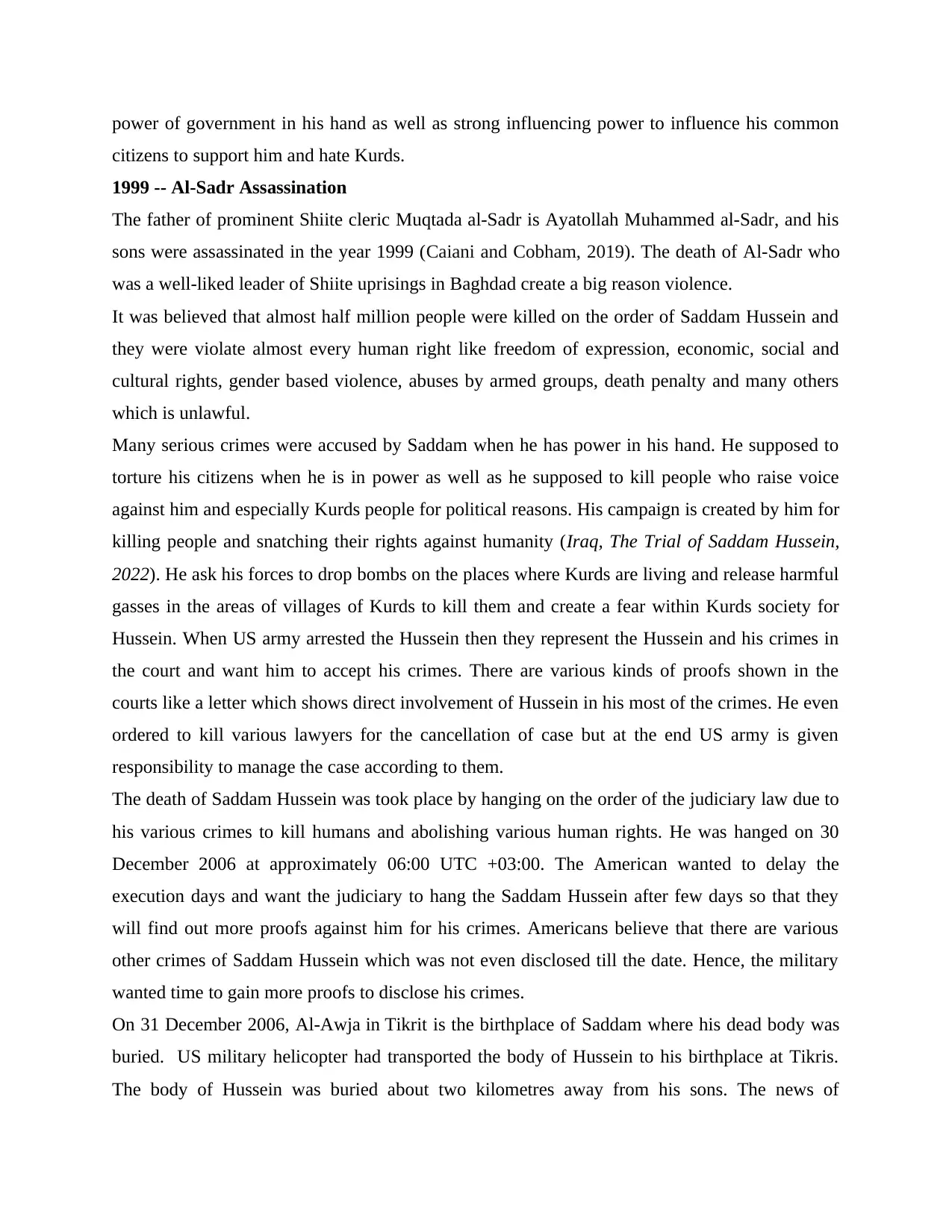
power of government in his hand as well as strong influencing power to influence his common
citizens to support him and hate Kurds.
1999 -- Al-Sadr Assassination
The father of prominent Shiite cleric Muqtada al-Sadr is Ayatollah Muhammed al-Sadr, and his
sons were assassinated in the year 1999 (Caiani and Cobham, 2019). The death of Al-Sadr who
was a well-liked leader of Shiite uprisings in Baghdad create a big reason violence.
It was believed that almost half million people were killed on the order of Saddam Hussein and
they were violate almost every human right like freedom of expression, economic, social and
cultural rights, gender based violence, abuses by armed groups, death penalty and many others
which is unlawful.
Many serious crimes were accused by Saddam when he has power in his hand. He supposed to
torture his citizens when he is in power as well as he supposed to kill people who raise voice
against him and especially Kurds people for political reasons. His campaign is created by him for
killing people and snatching their rights against humanity (Iraq, The Trial of Saddam Hussein,
2022). He ask his forces to drop bombs on the places where Kurds are living and release harmful
gasses in the areas of villages of Kurds to kill them and create a fear within Kurds society for
Hussein. When US army arrested the Hussein then they represent the Hussein and his crimes in
the court and want him to accept his crimes. There are various kinds of proofs shown in the
courts like a letter which shows direct involvement of Hussein in his most of the crimes. He even
ordered to kill various lawyers for the cancellation of case but at the end US army is given
responsibility to manage the case according to them.
The death of Saddam Hussein was took place by hanging on the order of the judiciary law due to
his various crimes to kill humans and abolishing various human rights. He was hanged on 30
December 2006 at approximately 06:00 UTC +03:00. The American wanted to delay the
execution days and want the judiciary to hang the Saddam Hussein after few days so that they
will find out more proofs against him for his crimes. Americans believe that there are various
other crimes of Saddam Hussein which was not even disclosed till the date. Hence, the military
wanted time to gain more proofs to disclose his crimes.
On 31 December 2006, Al-Awja in Tikrit is the birthplace of Saddam where his dead body was
buried. US military helicopter had transported the body of Hussein to his birthplace at Tikris.
The body of Hussein was buried about two kilometres away from his sons. The news of
citizens to support him and hate Kurds.
1999 -- Al-Sadr Assassination
The father of prominent Shiite cleric Muqtada al-Sadr is Ayatollah Muhammed al-Sadr, and his
sons were assassinated in the year 1999 (Caiani and Cobham, 2019). The death of Al-Sadr who
was a well-liked leader of Shiite uprisings in Baghdad create a big reason violence.
It was believed that almost half million people were killed on the order of Saddam Hussein and
they were violate almost every human right like freedom of expression, economic, social and
cultural rights, gender based violence, abuses by armed groups, death penalty and many others
which is unlawful.
Many serious crimes were accused by Saddam when he has power in his hand. He supposed to
torture his citizens when he is in power as well as he supposed to kill people who raise voice
against him and especially Kurds people for political reasons. His campaign is created by him for
killing people and snatching their rights against humanity (Iraq, The Trial of Saddam Hussein,
2022). He ask his forces to drop bombs on the places where Kurds are living and release harmful
gasses in the areas of villages of Kurds to kill them and create a fear within Kurds society for
Hussein. When US army arrested the Hussein then they represent the Hussein and his crimes in
the court and want him to accept his crimes. There are various kinds of proofs shown in the
courts like a letter which shows direct involvement of Hussein in his most of the crimes. He even
ordered to kill various lawyers for the cancellation of case but at the end US army is given
responsibility to manage the case according to them.
The death of Saddam Hussein was took place by hanging on the order of the judiciary law due to
his various crimes to kill humans and abolishing various human rights. He was hanged on 30
December 2006 at approximately 06:00 UTC +03:00. The American wanted to delay the
execution days and want the judiciary to hang the Saddam Hussein after few days so that they
will find out more proofs against him for his crimes. Americans believe that there are various
other crimes of Saddam Hussein which was not even disclosed till the date. Hence, the military
wanted time to gain more proofs to disclose his crimes.
On 31 December 2006, Al-Awja in Tikrit is the birthplace of Saddam where his dead body was
buried. US military helicopter had transported the body of Hussein to his birthplace at Tikris.
The body of Hussein was buried about two kilometres away from his sons. The news of
⊘ This is a preview!⊘
Do you want full access?
Subscribe today to unlock all pages.

Trusted by 1+ million students worldwide
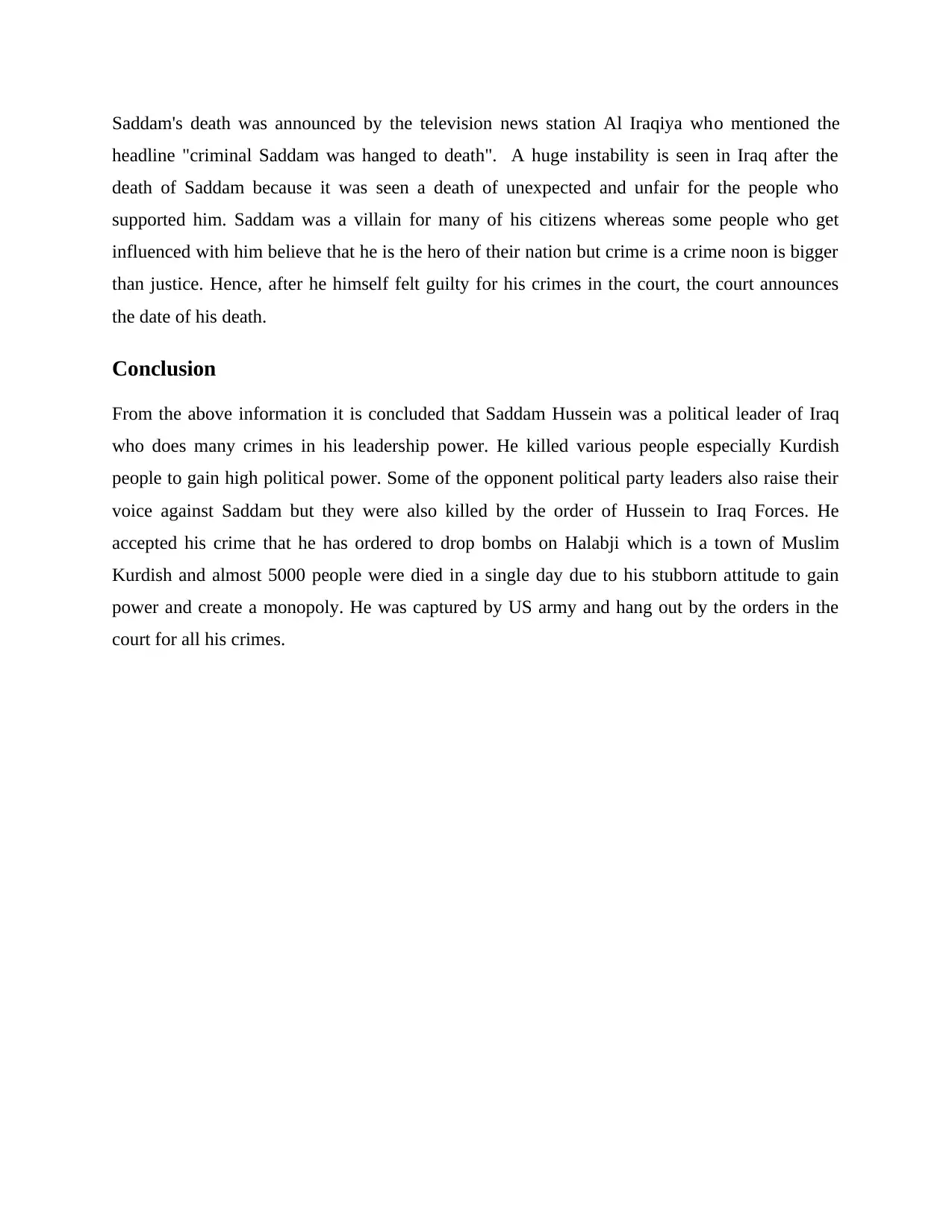
Saddam's death was announced by the television news station Al Iraqiya who mentioned the
headline "criminal Saddam was hanged to death". A huge instability is seen in Iraq after the
death of Saddam because it was seen a death of unexpected and unfair for the people who
supported him. Saddam was a villain for many of his citizens whereas some people who get
influenced with him believe that he is the hero of their nation but crime is a crime noon is bigger
than justice. Hence, after he himself felt guilty for his crimes in the court, the court announces
the date of his death.
Conclusion
From the above information it is concluded that Saddam Hussein was a political leader of Iraq
who does many crimes in his leadership power. He killed various people especially Kurdish
people to gain high political power. Some of the opponent political party leaders also raise their
voice against Saddam but they were also killed by the order of Hussein to Iraq Forces. He
accepted his crime that he has ordered to drop bombs on Halabji which is a town of Muslim
Kurdish and almost 5000 people were died in a single day due to his stubborn attitude to gain
power and create a monopoly. He was captured by US army and hang out by the orders in the
court for all his crimes.
headline "criminal Saddam was hanged to death". A huge instability is seen in Iraq after the
death of Saddam because it was seen a death of unexpected and unfair for the people who
supported him. Saddam was a villain for many of his citizens whereas some people who get
influenced with him believe that he is the hero of their nation but crime is a crime noon is bigger
than justice. Hence, after he himself felt guilty for his crimes in the court, the court announces
the date of his death.
Conclusion
From the above information it is concluded that Saddam Hussein was a political leader of Iraq
who does many crimes in his leadership power. He killed various people especially Kurdish
people to gain high political power. Some of the opponent political party leaders also raise their
voice against Saddam but they were also killed by the order of Hussein to Iraq Forces. He
accepted his crime that he has ordered to drop bombs on Halabji which is a town of Muslim
Kurdish and almost 5000 people were died in a single day due to his stubborn attitude to gain
power and create a monopoly. He was captured by US army and hang out by the orders in the
court for all his crimes.
Paraphrase This Document
Need a fresh take? Get an instant paraphrase of this document with our AI Paraphraser
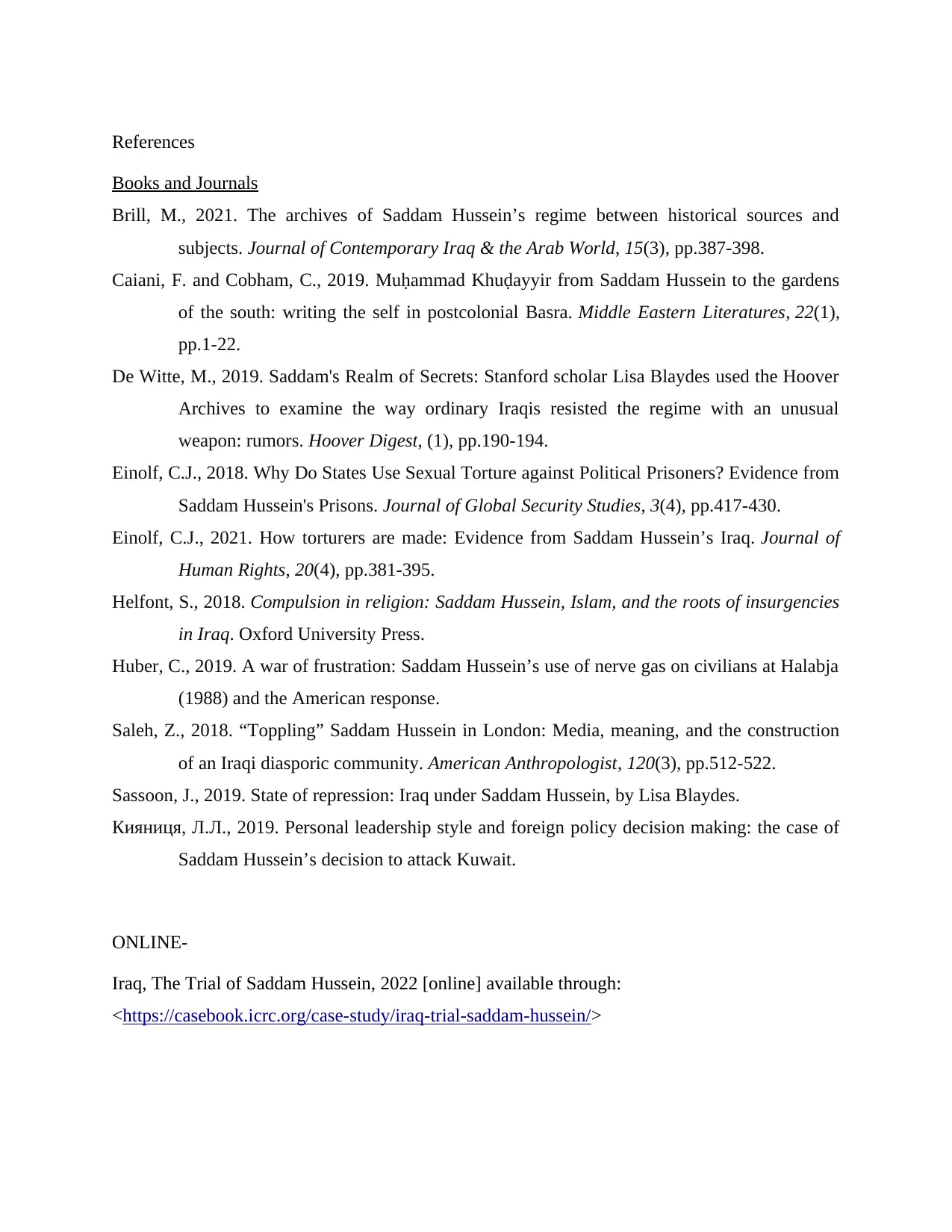
References
Books and Journals
Brill, M., 2021. The archives of Saddam Hussein’s regime between historical sources and
subjects. Journal of Contemporary Iraq & the Arab World, 15(3), pp.387-398.
Caiani, F. and Cobham, C., 2019. Muḥammad Khuḍayyir from Saddam Hussein to the gardens
of the south: writing the self in postcolonial Basra. Middle Eastern Literatures, 22(1),
pp.1-22.
De Witte, M., 2019. Saddam's Realm of Secrets: Stanford scholar Lisa Blaydes used the Hoover
Archives to examine the way ordinary Iraqis resisted the regime with an unusual
weapon: rumors. Hoover Digest, (1), pp.190-194.
Einolf, C.J., 2018. Why Do States Use Sexual Torture against Political Prisoners? Evidence from
Saddam Hussein's Prisons. Journal of Global Security Studies, 3(4), pp.417-430.
Einolf, C.J., 2021. How torturers are made: Evidence from Saddam Hussein’s Iraq. Journal of
Human Rights, 20(4), pp.381-395.
Helfont, S., 2018. Compulsion in religion: Saddam Hussein, Islam, and the roots of insurgencies
in Iraq. Oxford University Press.
Huber, C., 2019. A war of frustration: Saddam Hussein’s use of nerve gas on civilians at Halabja
(1988) and the American response.
Saleh, Z., 2018. “Toppling” Saddam Hussein in London: Media, meaning, and the construction
of an Iraqi diasporic community. American Anthropologist, 120(3), pp.512-522.
Sassoon, J., 2019. State of repression: Iraq under Saddam Hussein, by Lisa Blaydes.
Кияниця, Л.Л., 2019. Personal leadership style and foreign policy decision making: the case of
Saddam Hussein’s decision to attack Kuwait.
ONLINE-
Iraq, The Trial of Saddam Hussein, 2022 [online] available through:
<https://casebook.icrc.org/case-study/iraq-trial-saddam-hussein/>
Books and Journals
Brill, M., 2021. The archives of Saddam Hussein’s regime between historical sources and
subjects. Journal of Contemporary Iraq & the Arab World, 15(3), pp.387-398.
Caiani, F. and Cobham, C., 2019. Muḥammad Khuḍayyir from Saddam Hussein to the gardens
of the south: writing the self in postcolonial Basra. Middle Eastern Literatures, 22(1),
pp.1-22.
De Witte, M., 2019. Saddam's Realm of Secrets: Stanford scholar Lisa Blaydes used the Hoover
Archives to examine the way ordinary Iraqis resisted the regime with an unusual
weapon: rumors. Hoover Digest, (1), pp.190-194.
Einolf, C.J., 2018. Why Do States Use Sexual Torture against Political Prisoners? Evidence from
Saddam Hussein's Prisons. Journal of Global Security Studies, 3(4), pp.417-430.
Einolf, C.J., 2021. How torturers are made: Evidence from Saddam Hussein’s Iraq. Journal of
Human Rights, 20(4), pp.381-395.
Helfont, S., 2018. Compulsion in religion: Saddam Hussein, Islam, and the roots of insurgencies
in Iraq. Oxford University Press.
Huber, C., 2019. A war of frustration: Saddam Hussein’s use of nerve gas on civilians at Halabja
(1988) and the American response.
Saleh, Z., 2018. “Toppling” Saddam Hussein in London: Media, meaning, and the construction
of an Iraqi diasporic community. American Anthropologist, 120(3), pp.512-522.
Sassoon, J., 2019. State of repression: Iraq under Saddam Hussein, by Lisa Blaydes.
Кияниця, Л.Л., 2019. Personal leadership style and foreign policy decision making: the case of
Saddam Hussein’s decision to attack Kuwait.
ONLINE-
Iraq, The Trial of Saddam Hussein, 2022 [online] available through:
<https://casebook.icrc.org/case-study/iraq-trial-saddam-hussein/>

⊘ This is a preview!⊘
Do you want full access?
Subscribe today to unlock all pages.

Trusted by 1+ million students worldwide
1 out of 9
Your All-in-One AI-Powered Toolkit for Academic Success.
+13062052269
info@desklib.com
Available 24*7 on WhatsApp / Email
![[object Object]](/_next/static/media/star-bottom.7253800d.svg)
Unlock your academic potential
Copyright © 2020–2025 A2Z Services. All Rights Reserved. Developed and managed by ZUCOL.
